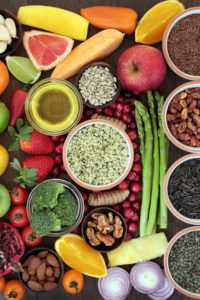What Happens in the Small Intestine?
Food passes from the stomach into the small intestine, where more digestion takes place, and the nutrients are absorbed into the body’s circulatory system. Once food is in the small intestine, the pancreas, liver, and gallbladder come into play. Digestive juices from these organs, along with enzymes on the cell border of the small intestine, contribute to the process.
The first section of the small intestine that receives food is called the duodenum. Enzymes secreted by the pancreas, plus bile from the gallbladder and liver, mix with food in the duodenum, where they break down carbohydrates, fats, and proteins. Bile— which is produced in the liver and stored in the gallbladder—dissolves fat, allowing the intestinal lining to absorb it. In addition, microorganisms called gut microbiota— which are present in the intestinal tract—help in the digestive process.
Get Your Nutrition Guide
Do you want to eat foods that help you feel better, stay slim, and avoid diet-related diseases? Do you want to be healthier by eating delicious “super” foods?
If so, claim your FREE copy, right now, of the definitive nutrition guide on living a longer, healthier, happier life.
The parts of the small intestine below the duodenum are called the jejunum and the ileum. Most absorption of the digested molecules of food takes place in these sections. The small intestine is an exceptionally long organ—about 22 feet in length—that is coiled up inside the abdomen. This length is necessary to accomplish the task of absorbing all the nutrients. The lining of the small intestine contains many folds and small projections (called villi and microvilli), which enhance contact with food, and provide more opportunities for absorption.
The now-small molecules of sugars, amino acids, and fatty acids are then absorbed through the walls of the intestine and into blood vessels and lacteals (thin-walled vessels that transport fat and white blood cells away from the intestine), which carry them to other parts of the body, where they help build, repair, and maintain body tissues and provide energy.
To learn more about how your digestive system works and ways to keep it healthy, purchase Digestive Diseases & Disorders from www.UniversityHealthNews.com.
The post What Happens in the Small Intestine? appeared first on University Health News.
Read Original Article: What Happens in the Small Intestine? »
Powered by WPeMatico


